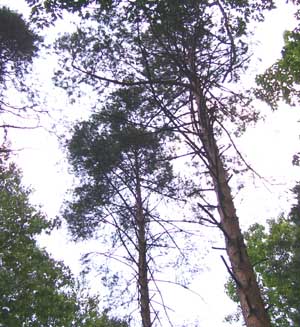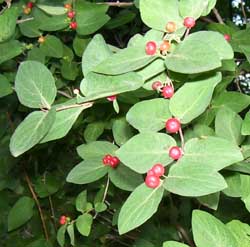Alder Pond Trail
Goodyear Heights Metro ParkMetro Parks, Serving Summit County
Trail Location
Akron, Ohio (Summit County)
From Interstate 76, take the Gilchrist Road Exit. Take a left and drive to Rout 91. Take Route 91 north to Newton Street. Head west on Newton Street. The park entrance will be on the north side of the road. Drive past the park entrance. Shortly you will come to East Park Boulevard. Turn North on this road. The parking lot that leads to the Alder Pond Trail is at the end of East Park Boulevard.

You will see the red, flaking bark of Scotch Pines as you walk along the Alder Pond Trail. These non-native pines were
likely planted by workers through government programs in the days of the great depression.
Trail Summary
Length: 1.4 miles
Duration: 1 hour
Surface: Natural and hard-packed gravel
Type:Loop Trail, Hiking
Difficulty: Easy, one slight hill at the northern extent of the trail
Accessibility: The surface of the trail may not be suitable for wheelchairs or those with unsteady footing, but it is fairly flat and hard packed.
Trail Description

A non-native bush honeysuckle with bright red berries along the Alder Pond Trail.
The Alder Pond Trail is a short trail that loops around Alder Pond and its associated wetland complex. The trail begins by going through a young forest composed of black cherry, red maple, red oak trees. The understory, or shrub layer, is composed of a mixture of non-native invasive shrubs, such as bush honeysuckle (Lonicera mackii, among other species), as well as native woodland shrubs such as spicebush and maple-leaved viburnum. You will notice as you hike that the wetter sections of forest, and the margins of the wetland, are more lush and green with vegetation, while the higher portions of the site generally have less vegetation.
Plants, like people, need sunshine, air, nutrients and water to thrive. The low lying areas that hold more water provide more moisture, hence the plants growing in these areas tend to grow more vigorously. Not only that, but you will notice that the species of plants growing in more wet, or hydric, situations are different than those growing in xeric, or dry spots. Just like everything else in nature, there is no black and white- the shades of gray make things much more interesting. Besides hydric and xeric sites, there are also mesic sites, those that are moister than xeric sites, but drier than hydric sites.
As you walk through the woods and across the boardwalk through the wetland, try to pick out hydric site conditions, more xeric conditions, and mesic conditions based on the number, size and types of plants growing. Of course, the ultimate xeric condition is a desert-don't look for that here. Our dry woods are only xeric compared to our own hydric and mesic sites.
The forests along this trail are generally young. However, you will see some large trees. Because tree species have different rates of growth, and even within a species growth rates are affected by site conditions, don't assume that the forest is old just because it has large trees. Likewise, do not assume a forest is young just because it has mostly small trees.
At the top of the only hill on the trail-just a slight rise really-is a patch of forest that probably was harvested or subject to disturbance last in the early to mid-1900's. Now there are trees in the two-foot diameter range, maybe more. These large straight trees are light-loving tulip poplars. These fast growing trees grow in openings, rather than coming up under an existing forest. However, there are slow growing American beech trees mixed here and there among the tulips. This indicates that the forest, but perhaps not the individual trees, has been around a while.
As you hike through here, you will see some of the typical forest wildflowers. Feathery False Solomon's Seal is fairly common. Along the trail you are likely to see enchanter's nightshade, and touch-me-nots. Wild Sarsaparilla grows here and there in the shade as well. An occasional warbler can he heard as you trapse through these woods, and on the pond, you may see mallards, muskrats, and if you are lucky, a large snapping turtle.
While this trail does not offer the solitude of trails in less urban areas, it is still an enjoyable walk through a healthy, developing forest. That should be salve for anyone's soul.
Nearby Trails
Parcours Trail
Piney Woods Trail
